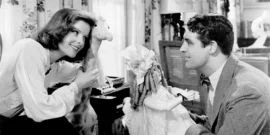The 1938 film showed us what is admirable in young women and what inspires young men.
Lost in the Cosmos
America is a strange country, and it seems we tend to celebrate that come summer. I’ll give you an example. There’s a very funny movie in theaters just now, Wes Anderson’s Asteroid City, that seems to include about two dozen famous actors, from Baby Boomers to Millennials, in roles large and small. It’s a very good production and only cost $25 million, since Hollywood stars queue up around the block to appear in Anderson’s movies, which nevertheless never win him any Oscars.
Asteroid City, Anderson’s tenth studio picture, is sure to be one of the top ten Hollywood movies of the year, but I don’t think it’ll make much money. How can you have this much star power, as we used to say, and fail to make bank, as we used to say? What’s all that beauty for if not for popularity? Maybe Anderson is too gentle for success—at any rate, that’s my guess as to why his sense of humor isn’t more appreciated. There is something gentle in his pointing out absurdity, as though he wished not to give offense to his fellow countrymen.
Perhaps another reason for Anderson’s lack of popularity is that his movies have largely not been about America, or at least not set in America. It’s only now in his 50s, well into middle age, that he has begun to make statements about the country, especially the mid-century moment when the country we see around us was formed, and especially the elites that did most to form it. His previous picture, The French Dispatch, was about literary aspirations, the hope to make America as sophisticated as Paris. Asteroid City is about the twin powers of mid-century America: atomic explosions and TV.
Mid-Century Confusion
Asteroid City is made of two interlocking parts. One is filmed in widescreen in a kind of postcard pastel palette, testimony to the innocent joy of that new birth of freedom after WWII. It’s a farce set in 1955, when widescreen filming was brand new, yet another American achievement that studios had worked on before the Great Depression, without figuring out how to make it profitable. The story mixes the grief of widower Augie Steenbeck (Anderson’s preferred lead, Jason Schwartzmann), with his kids in tow, with the national enthusiasm for science and technology in the Space Age.
The setting is Asteroid City, Nevada, in the desert—atomic test blasts in the background—the occasion is a science convention rewarding the whiz-kids of America, in a very inclusive, multi-ethnic setting that also includes girls. Nothing stopping women from being scientists (the local astronomer is played by Tilda Swinton). One of them is Augie’s teenage boy, Woodrow Lindbergh Steenbeck (pointing to an older America, where patriotism did occasionally incline men to name their boys for famous public figures). These kids have invented laser weapons, jet packs, and a way of projecting the American flag onto the moon, but they can hardly become friends, since their education doesn’t involve any self-knowledge and they are very unusual, to say nothing of the usual problems of American teenagers. The military-industrial complex applauds them: An Army General (Jeffrey Wright) and a representative for the sponsoring corporation (Bob Balaban), while disputing who owns the inventions.
Meanwhile, their all-American parents (Liev Schreiber, Hope Davis) look on the whole show with a mixture of unhappiness and incomprehension. There seems to be a lot of divorce in the background, a presage of things to come. Among them, Augie meets and falls for a kind of Marilyn Monroe actress named Midge Campbell (Scarlett Johanssen), who is chaperoning her daughter, who also is a whiz kid, while fleeing Broadway for Hollywood. They’re both damaged goods, perhaps because they have strange aspirations that go well beyond what’s available. Augie is a war photographer (he looks like a tiny Hemingway and seems based on Jimmy Stewart’s character in Hitchcock’s 1954 picture, Rear Window). Midge is a celebrity everyone desires. So somehow they cover beauty and ugliness, peace and war between them, and so they’re admired Americans. But neither is really fit to take care of kids; both are trying to be so important as to be admired. It’s a full-time job offering America entertaining images.
Thus a small desert town with an incompetent mechanic (Matt Dillon) and a not-much-more-competent motel owner (Steve Carrell) becomes the scene of the American question, what is the future? This much prosperity and peace should offer people something impressive, but what? Augie is set for California, like cowboys in the Westerns, the end of the frontier and the terrestrial paradise. (Also stranded in town, other symbols of America’s past and future: A group of cowboy singers led by Rupert Friend, including musicians Seu Jorge and Jarvis Cocker, and a busload of school kids getting their science education from an old-fashioned, pious young woman played by Maya Hawke.) But Augie is also tempted to dump his kids on his father-in-law who loathes him (Tom Hanks, playing a successful old WASP and looking like he might be in the middle of a round of golf at any given moment). Maybe alone is all Augie can be, and freedom is just another name for nothing left to lose. All the technology does not seem to have a good effect on morality—it’s not reassuring people about what they can do, and it may require them to take responsibility for the cosmos now that the atom and the vastness of space are somehow in the human grasp. Maybe these people are “lost in the cosmos,” having lost their homes as a price for their conquest of nature.
Asteroid City shows us how we become too powerful as a country to be happy or even content; and it suggests we have to deal with it now, since we can’t make our way back to a simpler time.
And amidst this tumult, the aliens come; or rather an alien ship with one alien, who just takes the city’s eponymous asteroid, and takes off. Then people do what you might expect, whether from old ’50s alien invasion movies or our own public health policies. Military despotism is promptly installed, lockdowns, quarantines, and a state of emergency with full censorship and control of the means of communications. Kids can’t stop talking about the alien; the adults want to go back to their lives but cannot find the interest in this possibly world-altering vision; truth be told, they just want to go back to their disappointing lives—that, too, is part of freedom. The whiz-kids organize a clever tech workaround and let America know about the alien, so the president decides to release everyone from this desert prison. Their lives are not transformed; some of the characters learn a little about each other or themselves, the kids especially learn to work together, and two of them overcome their shyness and fall for each other—all they needed was some time away from their ordinary lives, to stop and take each other a bit more seriously. That modest change is perhaps what we can hope for or advise.
The American Drama
This seems to be the theme of Asteroid City. The other part of the movie functions as a frame and it’s supposed to be a TV show about the making of the play which we see as a movie. It’s accordingly filmed in black and white, in the Academy Ratio (1.375:1, the ratio in which studio pictures were shot between 1932 and 1953, as a standard set by the Academy of Motion Picture Arts and Sciences, and which became a TV standard when the movies went widescreen). A TV presenter (Bryan Cranston) tells us the story of Conrad Earp (Edward Norton), the playwright, as well as Schubert Green (Adrien Brody), the play’s director, and Saltzburg Keitel (Willem Dafoe), the acting teacher at a kind of Actors Studio, where they recruited actors and thought about the meaning of the play.
These artists are stuck trying to understand themselves as Americans while trying to understand America artistically. Should they move on with the country, living the middle-class life now open to almost everyone? Or should they stand apart and take in the whole of America at the risk of not being part of it anymore? Does America want to be represented artistically? Can they persuade the audience to take their story as their own?
There’s no doubt America’s a great country. One piece of evidence is that artists like Anderson thrive in America. Another piece of evidence is that so many talented people self-destruct. It’s not clear whether we should think of them as sacrificing for our good, or at least our entertainment, or perhaps they are too disappointed because they cannot quite measure up to the greatness of America. The promise and achievement somehow don’t quite compare in most famous cases. In the mid-century, New York artistic elites tried to make sense of America’s destiny, and Asteroid City offers an account of how they failed. They are not quite up to their self-appointed task, and they cannot quite decide whether they wish to understand their own inner drama or they wish to show the American people a true vision of the country.
Part of Asteroid City’s humor comes from showing how disjointed America is. People with their ordinary lives have little idea nor much interest in atomic tests or scientific developments that might transform war or abolish peace; nor do ordinary people have much interest in artists, although they love to be entertained and, in a way, they love glamour. But the scientists or their government handlers do not understand the people either—nor do the artists. Anderson’s combination of earnestness and contrivance shows that we cannot quite put every group together in a coherent picture, though he mixes together quite a number of genres. Anderson is often mocked as an artist with a very limited range, unmoved by human passions, who makes doll house movies with his stylization because he’s not an adult. I’d say it’s better instead to look at his movies as realistic depictions of American life that we cannot ordinarily stand to recognize. He might be sparing our feelings by making his stories easy to dismiss or his insights easy to reject.
So I recommend Asteroid City. It’s more comic than dramatic, but you will find quite a lot of the bittersweet in it. It avoids sentimentality, but it shows us how we become too powerful as a country to be happy or even content; and it suggests we have to deal with it now, since we can’t make our way back to a simpler time. Comedy might be useful, since it encourages us to be less self-important and Anderson especially works to preempt anger or indignation. He risks making us feel helpless as we laugh at ourselves, but it may be very useful to take a moment away from our anxious hopes or our uncertain plans, and just see American life as it is, the sad and the humorous both.



